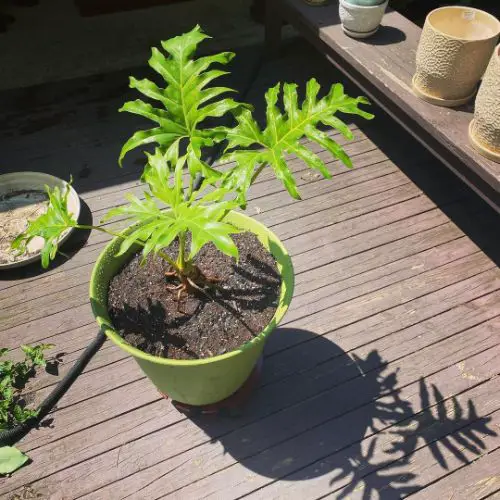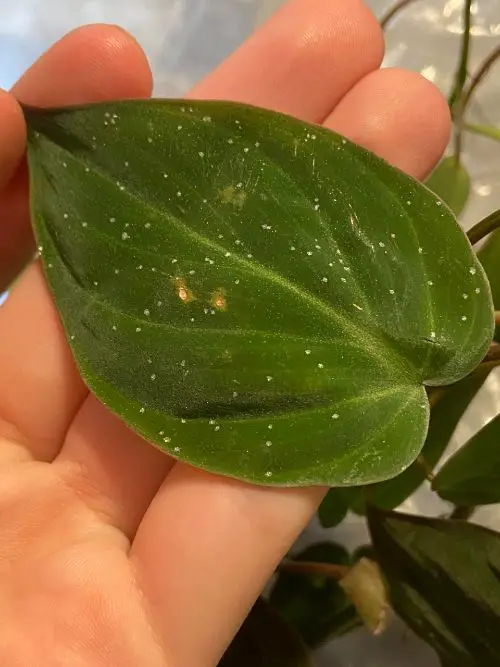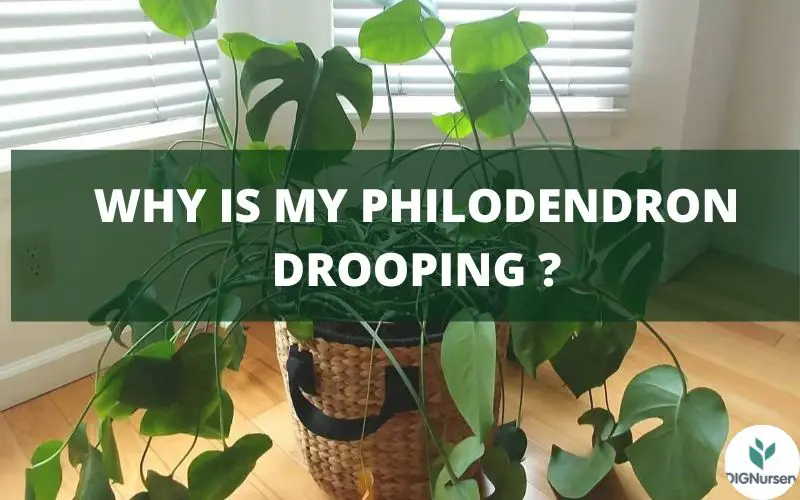Here is the question when you’ve noticed that your Philodendron has limp and drooping leaves. Don’t worry, this is a common problem for this type of plant. There are several reasons why your Philodendron might be drooping like: temperature, humidity, water, fertilizer, and repotting shock.
We’ll help you figure out what’s going on and how to fix it. Keep reading to learn more!
Why is my Philodendron drooping?
A Philodendron that is drooping indicates a problem with the plant.
You need to examine your care routine more carefully if your drooping Philodendron has yellowed, limp leaves. You must not rule out further potential causes.
I advise you to carefully examine the symptoms of your plant. You can take essential action if you are aware of the precise problem affecting your Philodendron. Philodendrons’ droopy leaves might have a number of causes like:
- Improper Temperature
- Watering issues: Overwatering and Underwatering
- Too much light and Lack of light
- Low Humidity
- Too much fertilizer
- Diseases and Pest
- Wrong container size
- Lack of Nutrients
Let’s examine the issues raised above in more detail.
Causes of Philodendron drooping
Improper Temperature
The ideal temperature for your Philodendron is between 60 and 80 degrees Fahrenheit. If the temperature is cooler than this, your plant’s leaves droop.
The philodendron is a tropical plant that prefers warm weather, so high temperatures might not be too bad for it. They will begin to exhibit brown leaves, stunted growth, and droopy leaves if the temperature falls below 50°F.
In the presence of dry air, dim lighting, and a lack of moisture, Philodendrons will sag or curl. Avoid exposing your Philodendron to extreme cold and low temperatures. It could lose its leaves, wilt, and appear sickly.
On the other hand, the soil will dry out more quickly in high temperatures, which might cause underwatering symptoms like drooping.
Watering issues: Overwatering and Underwatering
Overwatering
One of the most important elements that affect a plant’s health is water. Different issues will arise if you disregard the plant’s water requirements.
The potting mix will turn mushy and saturated if you give it too much water.
Keep in mind that roots require oxygen to breathe. Therefore, overwatering will smother the roots and result in fungal problems such as root rot if it is not corrected sooner.
Other symptoms of overwatering include the yellowing of leaves closer to the plant’s base, so keep a watchful lookout for those as well. Yellowing of the leaf veins may also be seen. The Philodendron leaves will begin to droop and can fall.
You may also like: Overwatered Philodendron: What You Need to Know
Underwatering
If you notice droopy leaves, underwatering may be to blame. Your Philodendron will adjust the first few times you ignore its water needs, but if you do it repeatedly, it will develop droopy leaves.
Philodendron will sad if you allow the soil to dry out because there won’t be enough water for the roots to absorb.
In the interim, water is still lost through transpiration and utilized in photosynthesis to produce energy.
Your plant will gradually become less turgid and droop and wilt as a result. Also, keep in mind that your Philodendron requires water to photosynthesize and make energy in order to grow.
Your plant will have concerning signs of underwatering if you don’t water it right afterward. These consist of:
- Foliage may turn yellow.
- Lower-level leaves will begin to wilt and drop off.
- To the touch, the leaves will feel arid and sharp.
- On the leaves, you could notice brown points or edges.
- The extremely dry earth is causing the potting mix to pull away.
- The curving, shriveling, or wrinkling of leaves.
Too much light and Lack of light
Too much light
If your Philodendron is placed in direct, bright light, it will flourish. The leaves will become sunburned and droop if you expose them to excessive light or direct sunlight for an extended period of time.
In their natural environment, Philodendrons defend themselves by finding shade behind larger trees to avoid sunburn from the heat. As a result, you shouldn’t keep the Philodendron in direct sunlight.
Even powerful artificial lighting can be detrimental to your Philodendrons. If the plant is exposed to these forms of light, the moisture will quickly evaporate from the leaves, drying them out.

Lack of light
Low light is also not advised for Philodendrons because the plant won’t be able to photosynthesize and the leaves will become dull and lifeless.
Your Philodendron’s leaves will lean in one direction if they are not receiving enough light, so watch for this.
While the plant’s other parts no longer appear to be growing, the stems will continue to get longer. They are an effort to nutrients and stretch towards the light.
The leaves of the Philodendron likewise droop and appear limp. All of these point to the Philodendron’s demand for additional light.
Low Humidity
The leaves will begin to droop and turn brown on the tips and edges if you plant it in a low-humidity environment.
Additionally, the soil will dry out more quickly, making these problems worse. Low humidity will cause the leaves to turn yellow if you don’t fix the problem. Leaf drying, wilting, and falling off may occur after that.
Even as indoor plants, tropical plants are accustomed to and even appreciate high humidity levels. Your Philodendron’s leaves will lose their luster and begin to droop if it doesn’t receive enough humidity.
Even a small fluctuation in the humidity level might be detrimental to your Philodendron.
You should take your Philodendron plant out of the area and move it to an area with some humidity if it is the window that gets cold drafts or close to a fireplace.
Too much fertilizer
A salt buildup in the soil brought on by over-fertilization may result in root and leaf burn. Problems like curling of leaves, brown tips, droopy on leaves, root rot, etc. will result from over-fertilizing your Philodendron.
When you overfertilize your Philodendron rather than under fertilized it, drooping is more likely to happen. You see, the roots will suffer severe harm if there is too much fertilizer applied.
Your Philodendron will droop because damaged roots can’t adequately absorb nutrients and water. White crusting on the topsoil is a sign of salt buildup from fertilizer.
Fertilizers should be fed to all plants on a regular basis, especially as the busy growing season begins. Fertilizer replenishes the nutrients that watering a plant over time can deplete from the soil.
Insect Infestation
Although Philodendrons rarely have pest problems, you might come upon a few. When pests like aphids, mealybugs, and scale insects, may begin to droop.
In many situations, sap-sucking insects, most notably mealybugs, are to blame drop. Pests spread quickly and can harm your plant by sucking up its sap and taking all of its nutrients.
They harm the foliage’s tissue as well.
Pests will cause a number of other issues for the Philodendron if the proper cultural conditions aren’t provided, and if you do nothing, the plant may even perish. During this period, overwatering your Philodendron could exacerbate the problem.

Diseases
Diseases like bacterial soft rot, stem rot, and fungal root rot can affect Philodendrons. Your Philodendron may droop, wilt, or even die as a result of all of these. Drooping can be brought on by a number of diseases. For starters, it has an impact on the root system’s performance and wellbeing
Wrong pot size
Philodendrons grow very quickly when the conditions are ideal, particularly in the early spring and summer. Your Philodendron will quickly run out of water, nutrients, and other resources if the pot is too tiny for it.
This could lead to either underwatering or overwatering, both of which result in the drooping of Philodendrons. You’ll be able to tell whether the container is too tiny by how your plant behaves: Broken pot, the growth of roots via the bottom drain holes.
Lack of Nutrients?
If your Philodendron is deficient in certain nutrients, it will appear weak. Drooping is typically brought on by a magnesium deficit. Leaf yellowing, falling, and drooping may also be caused by iron, manganese, and nitrogen deficiencies. Any color changes should be noted.
How to fix Philodendron drooping
If the leaves on your Philodendron are wilting, there are 9 things you can do to fix the problem.
Provide proper temperature
- Track the temperatures using a thermometer.
- Keep it in an environment with adequate heat and humidity if the temperatures fall below 50°F.
- Keep it in a warm environment and give it enough water.
- To raise the temperature around your Philodendron, place it close to a stove or furnace. To prevent the
Correct watering
Overwatering:
- Use a finger test to examine the humidity. You overwatered your Philodendron if it is wet. Your overwatered plant can be treated in a number of ways.
- If your plant is mildly overwatered, stop watering it. The soil will begin to dry out within a few days, and your Philodendron will almost instantly recover.
- Lack of drainage could be the issue. Verify the pot has drainage holes at the bottom and that the soil is well-drained.
- Make the appropriate changes and let the soil somewhat dry up.
- Drying the soil is necessary if it is moist and squishy. Place it somewhere where moisture can evaporate more easily. The soil can be turned upside down with a fork to hasten moisture evaporation.
Underwatering:
- Bring your Philodendron to the sink or tub.
- Water about 1L – 2L of water should be in the basin. Be sure to properly moisten it so that the water soaks into the roots and begins to flow via the drainage holes.
- Allow your plant to absorb water for longer than 45 minutes. Check the soil occasionally, and whenever the top 2-3 layers of soil feel dry, water your plant.
- Take your plant out of the sink, then tilt it to let the water drip out.
- Put it back on the saucer and create the ideal environment.
- If you want to water from above, continue doing so until water stops draining from the bottom holes. After letting it sit for ten minutes, drain any extra water from the saucer.
- Always examine the soil to make sure the top layers are dry and the plant is prepared for watering before following any watering schedule blindly.
- You can examine the soil by sticking a skewer, your finger, or a moisture meter into it.
- Keep your Philodendron in a position that is well-lit and ventilated so that the soil doesn’t stay damp for an extended period of time.
- If your Philodendron isn’t getting enough water, you should give it more frequently or more water overall.
Provide proper lighting
Too much light :
- Place your plant in a location where it will receive indirect light or medium light.
- Move it inside if it’s outside to reduce sunburns.
- Between the window and the Philodendron, curtains can disperse light so it feels like the sun but doesn’t suffer from its harmful effects.
Lack of light:
- Indirect light that is medium to bright is needed for Philodendrons. Put your Philodendron in a well-lit spot where it will receive adequate indirect light.
- Droopy leaves on the Philodendron may be caused by prolonged exposure to direct sunshine. If there is no natural light available, think about buying fluorescent lighting for the plant.
- For your Philodendron, a window or balcony with some indirect sunlight is excellent. If the plant receives direct sunshine, keep it a few feet away from the window.
Provide proper humidity
- To improve the humidity, group your Philodendron with other houseplants.
- To enhance humidity, spray your Philodendron every day so the leaves are not wet.
- Your Philodendron should be situated on or near a humidity tray.
- Use a humidifier to check humidity.
- Keep the appropriate humidity level near your Philodendron, and keep a humidifier nearby. This is essential, especially in the winter.
- Misting can occasionally assist in maintaining humidity, but you shouldn’t do it too frequently.
Correct fertilization
- For at least 45 minutes, irrigate the soil with water to remove surplus fertilizer.
- Let the soil dry while tilting to drain excess moisture.
- You should give it the proper amount of fertilizer rather than overfeeding it with too much of it.
- During the spring and summer, the Philodendrons require fertilization once or twice a month because they develop quickly.
- Before feeding your Philodendron the specified dose, you should dilute it and make it half-strength.
- Since the plant goes dormant in the winter and doesn’t need fertilizer at this time, you should start reducing the amount of fertilizer you apply starting in the fall.
Get rid of Insect Infestation
- The greatest method of preventing pest infestations is to control pest attacks because it is safe for your plants.
- To get rid of pests, give your Philodendrons a thorough wash under running water. But watch out that the water doesn’t pool on the ground or the leaves of the plant.
- Do this every one to two weeks until the pests are eliminated.
- Trim away any leaves that are excessively diseased, damaged, or dead.
- When washing the plant, use cold water because hot water might be damaging to the plant.
- Every time, treat the plant with horticultural oils (like neem oil), rubbing alcohol, or insecticidal soaps.
- If you want to use neem oil to get rid of the pests, you can spray 1/2 tbsp of neem oil with 1 cup of water all over the plant.
- Pests that are still visible to you can be manually removed.
- You can also use commercially available chemical pesticides, but you should use caution because they may harm your Philodendrons
Treat diseases
- Check your Philodendron carefully for signs of illness or disease. The type of sickness will determine the best course of action.
- It’s crucial that you eliminate and discard any infected, dead, or severely harmed plant portions.
- When necessary, use an antibacterial treatment or antifungal.
- Use cinnamon, hydrogen peroxide, or activated charcoal for natural remedies.
Choose proper pot
- You repot your Philodendron in a larger container.
- You should switch plants to other fertile and well-drained soil.
- If you use the size of the pot is too small, you be watering once a week should be proper for the plant because the soil will take less time to dry.
- But if you use a big container for Philodendron, it will hold more water, and the soil will take much time to dry. Therefore, the plant will need less water than usual.
Provide nutrients
- Apply balanced Philodendrons fertilizer monthly during the period of rapid growth, which is often spring and summer by using magnesium sulfate
- For Philodendrons to flourish, the soil must drain effectively. For Philodendrons to remain healthy, the soil and roots must have adequate air circulation.
- The necessary nutrients and water will be retained by the proper soil mixture. An excellent soil mixture can be made by including:
– Peat-based soil mixture.
– Compost and perlite in equal parts.
– The soil mix will receive enough nutrients from this soil.

How to keep Philodendrons healthy?
First, make sure you’re giving it the right amount of water. Overwatering or underwatering can both cause problems for your plant. Try bottom watering if you want to provide moisture to the root in all areas.
Second, be sure to follow the directions on the fertilizer package. Too little or too much fertilizer can also cause problems for droop leaves.
Third, Keep Philodendrons in a spot that receives enough indirect light but not sunlight. To keep the plant from being leggy, rotate it occasionally.
Fourth, never purchase a pot that is either too large or too tiny for the plant because doing so could cause overwatering of the roots. Use containers made of materials like wood or terracotta, since these will help the roots retain some moisture and allow for good airflow.
Finally, when you repot a plant, it can go through a period of stress called “repotting shock.” This can cause the leaves to droop. To avoid this, be sure to acclimate your plant to its new pot slowly.
That’s it! By following these tips, you can keep your Philodendron healthy and happy.
Conclusions:
It is possible that your Philodendron drooping is due to any of the reasons we’ve listed, or it could be from a combination of factors. In order to keep your Philodendron healthy and thriving, follow these simple tips we shared.


